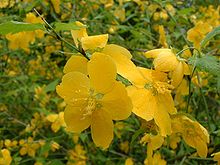Kerria japonica
| Kerria japonica | |
|---|---|

| |
| Natural form | |

| |
| Cultivar 'Pleniflora' | |
| Scientific classification | |
| Kingdom: | Plantae |
| Clade: | Tracheophytes |
| Clade: | Angiosperms |
| Clade: | Eudicots |
| Clade: | Rosids |
| Order: | Rosales |
| Family: | Rosaceae |
| Subfamily: | Amygdaloideae |
| Tribe: | Kerrieae |
| Genus: | Kerria DC. |
| Species: | K. japonica
|
| Binomial name | |
| Kerria japonica | |
Kerria japonica, commonly known as Japanese kerria[1] or Japanese rose,[2] is a deciduous, yellow-flowering shrub in the rose family (Rosaceae), native to China, Japan and Korea. It is the only species in the genus Kerria. In the wild, it grows in thickets on mountain slopes. A double-flowered cultivar, K. japonica 'Pleniflora', is commonly called bachelor's buttons.
Description
Kerria japonica grows to 1–3 m (3.3–9.8 ft) tall, with weak arching stems often scrambling over other vegetation or rocks. In the wild it grows in thickets on mountain slopes. The leaves are alternate, simple, 3–10 cm long, with a doubly serrated margin. The flowers are golden yellow, with five petals, and evenly-spaced along branches of new green growth. The fruit is a dry single-seeded achene 4–4.5 mm long.[3]
Cultivation
Kerria is valued in gardens for its golden yellow flowers, which appear in the spring. It is best grown with some shade from full sunlight to avoid blanching the flowers, and needs to be pruned after flowering to maintain health and vigour.[4] Two cultivars have gained the Royal Horticultural Society's Award of Garden Merit, K. japonica 'Golden guinea'[5] and the double-flowered K. japonica 'Pleniflora', commonly known as bachelor's buttons.[6][7]
Pests and diseases
Since 2014 the UK's Royal Horticultural Society has been receiving reports from gardeners and horticulturalists of damage to plants of the shrub Kerria japonica. Symptoms include multiple red spots on leaves, and lesions on the stems, resulting in defoliation and eventual death. It has been determined that this infection is caused by the fungus Blumeriella kerriae, which is specific to the kerria. This highly contagious disease, known in English as kerria twig and leaf blight, was known in the U.S. but has not previously been observed on British plants. It is regarded as a serious threat to the cultivated kerria plants, which are popular garden shrubs.[8]
Medicinal use
The plant has anti-inflammatory properties and a decoction of the flowering shoots with honey has been used in China in the treatment of coughs and gynecological disorders.[9][10]
Chemistry
The leaves and roots contain 0.002% Hydrogen cyanide, while the tender shoots are a rich source of Vitamin C (200 mg/100g) and the seeds contain 44.9% protein and 45.3% fat.[10] The flower petals contain the O-methylated flavonoid pectolinarin, (5,7-dihydroxy-4,6-dimethoxyflavone-7-rutinoside), a cytotoxic compound known also as Neolinarin and found also in Linaria spp., Kickxia elatine and the Duranta species D. plumieri.[11]
References
- ^ "Kerria japonica". North Carolina Extension: Gardener Plant Toolbox. Retrieved 16 March 2021.
- ^ "Kerria japonica". USDA Plants Database. Retrieved 16 March 2021.
- ^ Li Chao-luang, Hiroshi Ikeda & Hideaki Ohba. "Kerria japonica". Flora of China. Missouri Botanical Garden, St. Louis, MO & Harvard University Herbaria, Cambridge, MA. Retrieved 8 July 2012.
- ^ "How to prune a Kerria japonica". SF Gate Homeguides. Retrieved 17 March 2018.
- ^ "RHS Plant Selector - Kerria japonica 'Golden Guinea'". Royal Horticultural Society. Retrieved 27 September 2020.
- ^ "RHS Plant Selector - Kerria japonica 'Pleniflora'". Royal Horticultural Society. Retrieved 27 September 2020.
- ^ "AGM Plants - Ornamental" (PDF). Royal Horticultural Society. July 2017. p. 57. Retrieved 14 March 2018.
- ^ "Kerria twig and leaf blight". Royal Horticultural Society. Retrieved 16 March 2018.
- ^ Quattrocchi, Umberto (2012). CRC World dictionary of medicinal and poisonous plants: common names, scientific names, eponyms, synonyms and etymology, CRC Press Taylor and Francis Group, vol III E-L, pps. 661-2.
- ^ a b Duke, A. and Ayensu, Edward S., Medicinal Plants of China, pub. Reference Publications, inc. 1985 vol. II ISBN 0-917256-27-1 p.546.
- ^ Blunt, John W. and Munro, Murray H. G. Dictionary of Marine Natural Products pub. Chapman & Hall/CRC Taylor and Francis Group 2007 page 614.
External links
 Media related to Kerria japonica at Wikimedia Commons
Media related to Kerria japonica at Wikimedia Commons Data related to Kerria at Wikispecies
Data related to Kerria at Wikispecies
